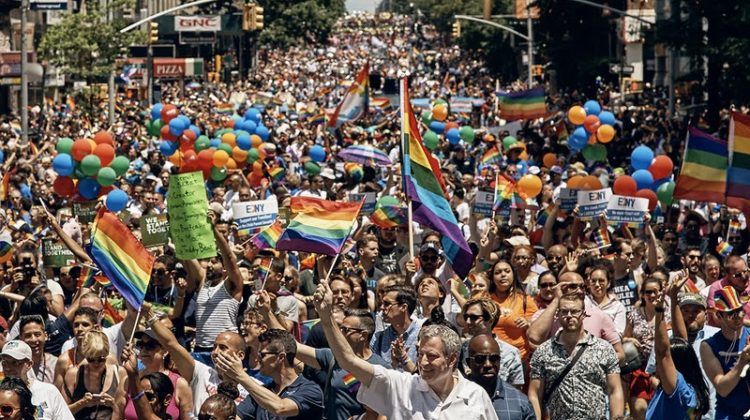
2018 New York City Pride March. Photo Credit: ABC News.
A Tragic Beginning
The Lesbian, Gay, Bisexual, Transgender, Queer/Questioning, Intersex, Asexual/Agender (LGBTQIA+) community is tied to cannabis as a result of the AIDS crisis. Before the immune disorder that ravaged the U.S. even had its name, it had affected 335 people and killed 136. Since it initially seemed to affect gay men, officials labeled it as “gay-related immune deficiency, or GRID,” reports History.
Not long after, AIDS received its official name. It spread rapidly through the exchange of bodily fluids as doctors scrambled to treat a disease that had no precedent.
In 1987, the first antiretroviral medication for HIV, azidothymidine (AZT), became available, reports History. However, AZT often worsened the already devastating side effects of HIV.
According to Clinton Werner, cannabis researcher and author, “one of the primary killers of AIDS patients was a wasting syndrome that resulted from a number of illness-linked influences […]. Wasting is defined as the loss of more than 10% of baseline bodyweight.”
Ironically, AZT often further suppressed the appetites of patients who desperately needed to gain weight, also causing gastric distress.
The need to treat these aggressive symptoms forged the medical, cultural and historical link between the cannabis movement and the LGBTQIA+ community. In addition to relieving pain, Werner writes that cannabis “not only eased and abated the gastrointestinal distress from both illness and remedy, but induced a voracious hunger,” known widely as “the munchies.”
Cannabis consumption thus became an unorthodox way to treat AIDS in the early 1980s. It also alleviated other symptoms. Those included nausea, vomiting, pain, anxiety, stress and depression, according to Americans Safe Access (ASA), an organization that advocates for medical cannabis research.
The Queer Fight for Legalization
While bigoted individuals still mis-labeled AIDS as the “gay plague,” further research revealed that all people, particularly those who engaged in sexual activities with a partner with HIV, were in danger. However, the push to legalize medical cannabis was effectively lead by the LGBTQIA+ community, as gay and bisexual men were and are disproportionality affected by the disease, reports the National Institute of Health.
To put it bluntly, cannabis would be nowhere near as accessible as it is today without the work of queer activists who struggled to create change.
Currently, 36 states, as well as the District of Columbia, Guam, Puerto Rico, and U.S. Virgin Islands, “have approved comprehensive, publicly available medical marijuana/cannabis programs,” reports the National Conference of State Legislatures. Additionally, 17 states and the District of Columbia have enacted legislation to regulate adult-use cannabis.

Without the LGBTQIA+ community’s significant contribution to the cannabis movement, this level of availability would be impossible to imagine.
As Daniel Saynt, founder of the NSFW Creative states in Rolling Stone, “[the] legalization of cannabis wouldn’t be a thing if it wasn’t the LGBTQ community.”
Some figures, in particular, stand out for their notable achievements.
“The Father of Medical Marijuana”
We would be remiss if we did not mention Dennis Peron. Peron is widely credited as the “Father of Medical Marijuana,” who passed away in 2018. From cannabis dealer to political activist, Peron was motivated to decriminalize the possession of cannabis for medical treatment. He was motivated after witnessing how it assisted his former lover Johnathon West, who was dying from AIDS in the early 1990s, according to the San Francisco Chronicle.
Cannabis was effective in easing the nausea and pain West endured as a result of the medication he took. After West’s death, Peron joined with other activists to draft the famous Proposition P. The prop asked San Francisco to recommend that California add cannabis to its list of approved medicines to treat various diseases, including AIDS, glaucoma, cancer, and multiple sclerosis. They also asked that officials not penalize doctors who prescribed it, reports The New York Times.

The measure passed resoundingly. Peron then joined others in lobbying for statewide access to medical cannabis. He did so while maintaining his own minor medical dispensary called the San Francisco Cannabis Buyers’ Club. Originally opened for AIDS and cancer patients in search of treatment, the club soon became a hub of support and acceptance for the seriously ill.
Peron faced various obstacles on the path to legalization. For example, in 1996, state narcotics agents raided his dispensary and shut it down. As a result, officials arrested Peron for cannabis possession and criminal conspiracy, reports The New York Times. In spite of this resistance, voters passed Proposition 215 and legalized medical cannabis in California. Two decades later in 2016, California voters approved Proposition 64, legalizing recreational marijuana in California.
Looking Forward
Peron’s legacy lives on in the continued fight for widespread and equal access to cannabis in the U.S. Future cannabis users remain indebted to this larger-than-life queer activist.
Peron is only one among hundreds of LGBTQIA+ activists who proved instrumental in the effort to legalize and de-stigmatize cannabis. Without their efforts, it is clear that the cannabis movement would not have advanced with such vigor. In the month of Pride, it is crucial to remember and honor the pain and suffering the members of this community endured to gift the modern cannabis consumer with far easier access to an effective medicine. Raise that rainbow flag high and remember that without queer people, legal cannabis in any form would be but a humble daydream.



Leave a Reply